sea lion shootings
Shot sea lion numbers end bleak year
Dec/24/20 09:15 AM
2020 has been a tough one on so many levels for Puget Sound’s marine mammal stranding networks.
The unlawful and rampant shootings of sea lions has ended the year on a frustrating, infuriating and tragic note. At last count, out of 23+ sea lion carcasses since Fall, there have been 14 confirmed shot dead. Three additional carcasses are pending radiographs, along with another 2 highly suspect deaths. Others were unable to be examined due to location. Several additional sea lion carcasses have been sighted floating in Elliott Bay, but disappeared before the networks were notified and able to respond.
Sea lions and seals are unwitting and unjustified scapegoats for dwindling fish stocks; the annual rash of shootings typically corresponds with fish runs and fishing seasons.
The unlawful and rampant shootings of sea lions has ended the year on a frustrating, infuriating and tragic note. At last count, out of 23+ sea lion carcasses since Fall, there have been 14 confirmed shot dead. Three additional carcasses are pending radiographs, along with another 2 highly suspect deaths. Others were unable to be examined due to location. Several additional sea lion carcasses have been sighted floating in Elliott Bay, but disappeared before the networks were notified and able to respond.
Sea lions and seals are unwitting and unjustified scapegoats for dwindling fish stocks; the annual rash of shootings typically corresponds with fish runs and fishing seasons.
Deadly week as two sea lions confirmed shot
Oct/05/20 05:58 PM
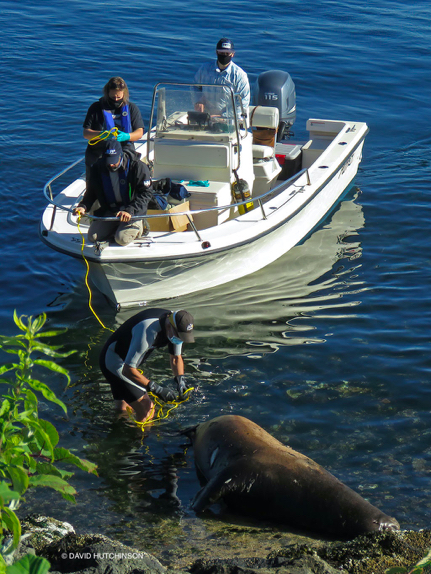 Necropsies performed on two dead California sea lions in West Seattle this week confirmed suspicions that both animals had been shot to death. There have been multiple reports of gunfire this past week in the Duwamish River where fishing boats and nets have been present.
Necropsies performed on two dead California sea lions in West Seattle this week confirmed suspicions that both animals had been shot to death. There have been multiple reports of gunfire this past week in the Duwamish River where fishing boats and nets have been present.On Saturday (10/3) Seal Sitters MMSN facilitated the necropsy of a dead, robust California sea lion found two days earlier, mysteriously tied to a pier in the East Waterway of the Duwamish. The animal was towed ashore to Don Armeni boat launch where an examination was done by SR3 with assistance from Seal Sitters and Sno-King Marine Mammal Response. Numerous pellets were found in his flipper, chest and head, along with massive internal hemorrhaging. The head was taken for radiographs which revealed additional projectiles in the skull.
Earlier in the week, Seal Sitters and SR3 conducted a necropsy on a sea lion that had been found floating offshore. That animal suffered a shattered vertebrae, broken rib and internal organ damage. X-rays showed projectiles in the skull.
Evidence from both examinations will be turned over to NOAA’s Office of Law Enforcement for investigation.
As always, Seal Sitters is extremely concerned about this annual shooting of pinnipeds during fishing seasons. Concurrent with Fall and Winter fish runs, numerous sea lions and seals pay a deadly price. As in past years, guns are being fired over open water in a busy recreational, commercial and industrial area of the City of Seattle. This latest shooting happened directly across from fuel barges and fuel storage tanks, near docks active with workers. Last year, shootings were witnessed in Elliott Bay in ferry and water taxi lanes.
If you hear active gunfire over the water, please call 911. If the gunfire is in Elliott Bay, after calling 911, notify Seal Sitters’ hotline at 206-905-SEAL (206-905-7325). To find out the stranding network for your area of Puget Sound, click HERE.
If you see a stranded marine mammal, dead or alive, in West Seattle, please call Seal Sitters’ hotline at 206-905-SEAL (206-905-7325).
$20k reward offered for leads on shot sea lions
Feb/06/19 12:17 PM
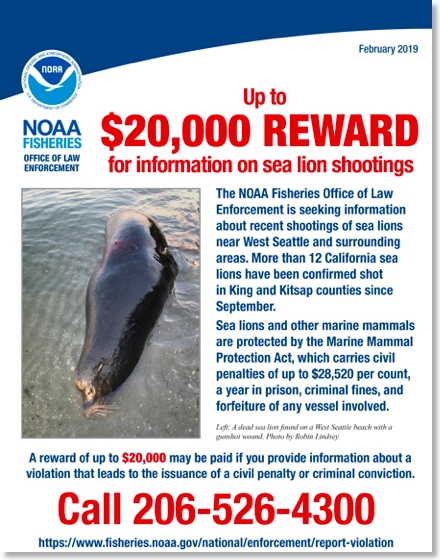 In September of 2018, a dark turn of events began to unfold along the shoreline of Seattle’s Elliott Bay and nearby waters of Puget Sound. Sea lions started showing up dead.
In September of 2018, a dark turn of events began to unfold along the shoreline of Seattle’s Elliott Bay and nearby waters of Puget Sound. Sea lions started showing up dead. Over the next several months, a total of 18 of the large marine mammals washed ashore in King and Kitsap counties. Of the 12 that researchers were able to examine and necropsy, all were confirmed shot, most with projectiles lodged in the head. One was decapitated.
Seal Sitters MMSN responded to 9 sea lion carcasses in West Seattle alone. The California sea lion at left, found near Alki Beach, was shot in the back and suffered a slow death from massive internal injuries.
Due to logistical difficulties, the other animals disappeared with the tides before necropsies could be done. However, based on body condition from photographs or external exam, all were considered to be suspected victims of acute trauma. All of the deaths occurred in conspicuous conjunction with seasonal fish runs.
Up to $20,000 has been offered by NOAA’s Office of Law Enforcement (OLE) for information leading to penalty or conviction in the recent shootings. Numerous reports were placed to Seal Sitters hotline about shots heard in Elliott Bay during the time period when most of the shootings appear to have occurred. Surely, someone out there knows something about the perpetrators - saw suspicious activity or maybe even heard someone boast about the killings. If you have any information at all, please contact OLE at 206-526-4300.
For additional photos and to read all related stories regarding the 2018 sea lion shootings, click here.
To print out and post a reward flyer, click here.
Latest numbers - shot sea lion count increases to 12
Dec/07/18 02:43 PM
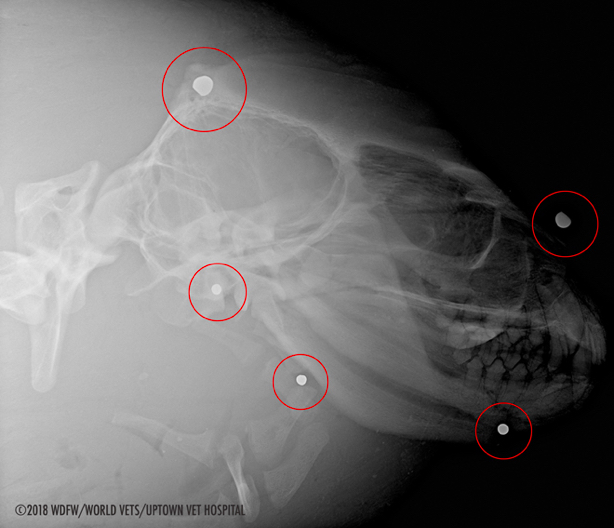 LATEST UPDATE 12/7/18 2:45PM
LATEST UPDATE 12/7/18 2:45PMThese numbers are ever increasing. Please check back frequently for updated statistics.
THE LATEST STATS
The number of reported dead sea lions now totals 18 in King and Kitsap counties of Puget Sound for the period September to date in December 2018. Additionally, there are reports of several dead animals in neighboring counties. The Marine Mammal Stranding Network is gathering data from those counties and that information will be shared when possible. The animals (based on either exam or photos and body condition) are suspected to have died from acute trauma. Acute trauma can be caused by a number of incidents, including human interaction (shooting, boat strike, etc) or killer whale/shark attack.
Following the necropsies on 12/4 and 12/5 of two decomposed sea lion carcasses that came ashore in West Seattle, the latest number of confirmed shot sea lions in King and Kitsap counties now totals 12. Both animals were shot in the head.
We want to emphasize that these latest few cases were in advanced decomposition and are not newly shot animals, just newly found. They were likely killed during September/October and early November when the clusters of shootings seem to have occurred.
The head of another sea lion in West Seattle on Friday, 11/30, was X-rayed, confirming the animal had been shot, as well as an Indianola sea lion who was confirmed shot dead on 11/29. The one investigated 11/25 on Vashon Island was necropsied the following day. X-rays of the skull revealed projectiles. The decomposing sea lion carcass found Thanksgiving Day wedged against the West Seattle Water Taxi dock has been confirmed shot as well. These are just the most recent victims of violence. The radiograph above is the skull of the sea lion necropsied in West Seattle on the 15th, showing 5 shotgun pellets of 2 different calibers lodged in the head.
The California sea lion below was shot in the back, suffering massive injuries to internal organs and a slow death.
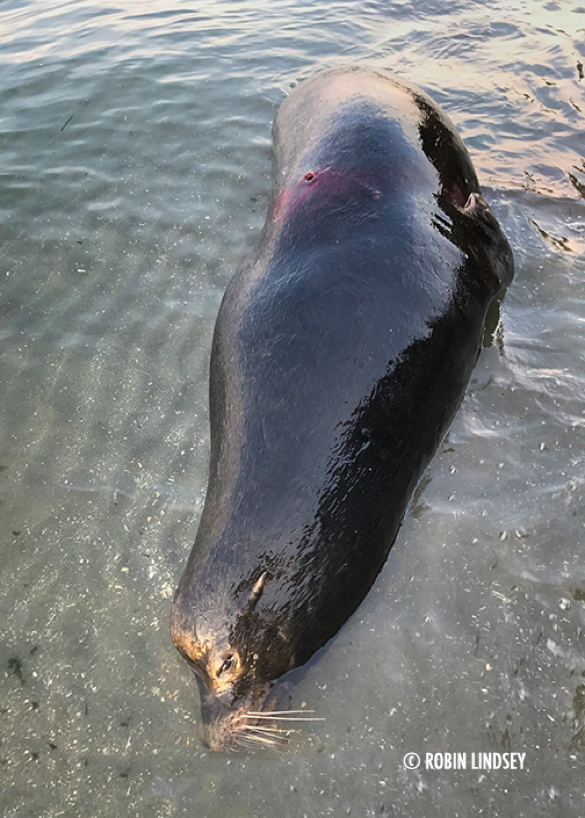 THE RESPONSE
THE RESPONSEThe response to these dead animals has been a collaborative effort on the part of several partners in NOAA’s Marine Mammal Stranding Network, those who cover the extensive coastline of Central and South Puget Sound: Washington Department of Fish and Wildlife Marine Mammal Investigations (WDFW-MMI), Sno-King Marine Mammal Response and Seal Sitters MMSN. Seattle-based organization SR3 has provided invaluable support to the Network.
THE CHALLENGES
WDFW-MMI does the bulk of all pinniped (seals and sea lions) necropsies in Puget Sound and the outer Pacific coast of Washington.
Because an EPA permit is required to tow and sink a dead marine mammal (which has taken days to weeks), that causes delays in the ability to promptly necropsy a sea lion because of disposal issues. You can’t leave a cut up 600 lb animal carcass on private or public beach. It either needs to be towed out to sea and sunk at an approved lat/long or disposed of onshore. Often, there is no vehicle access and even if so, there are limited resources to pay for heavy equipment burial onsite - or for rendering at a plant. Rarely can a cut up carcass be left onshore - only in remote locations. For these reasons, some of the animals who could not be secured have disappeared with the tides before a necropsy could be done.
The Stranding Network thanks the region’s veterinarians for assistance in providing radiographs of heads taken to their clinics. Often, a radiograph is the only means to locate a bullet lodged in an animal. A portable, battery-powered X-ray machine used in the field would reveal instantly if there were shot pellets. Then, the animal could remain intact while awaiting necropsy and the EPA permit for disposal, but at least in the interim a diagnosis would have been confirmed. However, at a cost of $25-30k, obtaining one is far out of reach with slashed marine mammal response budgets.
For all related shot sea lion posts, click here.
Shot sea lion numbers rise in Puget Sound
Nov/21/18 11:56 PM
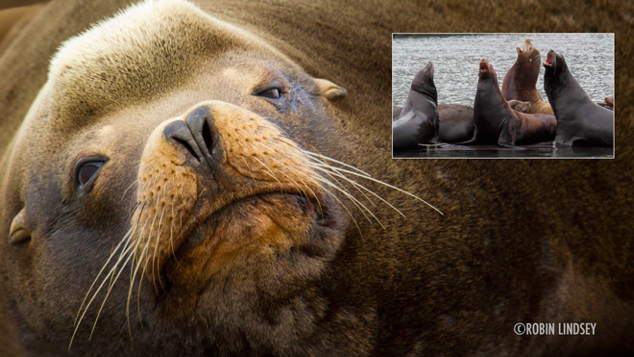
UPDATE 11/25/18
In response to the many media inquiries, Seal Sitters MMSN would like to confirm that the numbers of confirmed shot and “suspected” shot sea lions is significantly higher than normal for this annual time period. A query of the NOAA National Marine Mammal Stranding database, looking back at 10 years of statistics for King and Kitsap counties, indicates that the current confirmed number of shot sea lions is 6 times higher than the yearly average for months September-November. This only reflects the number of found and reported animals. With seven additional suspect animals, that number is expected to increase. The “high” season for shot sea lions (Dec/Jan/Feb) is still to come, concurrent with fish runs.
SHOT SEA LION NUMBERS RISE (11/21/18)
In what is an alarming trend in Puget Sound, dead California sea lions continue to be found along the shoreline as biologists scramble to perform necropsies and determine cause of death.
Since September, 13 have been reported dead: 12 in Central Puget Sound and 1 on the Kitsap side of Hood Canal. Of those, 6 have been necropsied thus far and confirmed shot: 4 in West Seattle and 2 in Kitsap County. This past week, a sea lion carcass washed up in a small cove near Salty’s restaurant in West Seattle. The head had been sliced off. Due to decomposition, a necropsy was not performed. In view of potential delays securing an EPA permit for towing and sinking, Seattle Parks buried the huge carcass today on site.
All 13 animals are acute trauma cases (suspected from human interaction), based on body condition, other observations and photos. Unfortunately, several of the animals disappeared with the tide before exams could be done.
Sadly, this is just the beginning of what is likely to be a very deadly Fall/Winter season for sea lions and seals. Shootings not so coincidentally increase in correlation with fish runs, year-round. According to those who live and work along the Elliott Bay and Duwamish waterfront, shots are being heard even more frequently this year. Animals searching for food to survive and fishermen searching out fish for consumption or livelihood are on an annual, never-ending collision course.
Marine Mammals are protected by Federal law. It is illegal for a private citizen to “take” (kill, injure or harass) pinnipeds (seals and sea lions), with fines up to $25,000 and imprisonment. In certain, limited circumstances, tribal fisheries can do so. There is an active and open investigation into these killings by OLE and WDFW Enforcement. For NOAA’s official statement, please click here. For inquiries, please contact Michael Milstein, NOAA Public Affairs Officer @ 503-231-6268.
REPORT INCIDENTS
Please be on the alert. NOAA urges the public to report any information or incidents (shooting or harassment) they see or hear to NOAA Office of Law Enforcement (OLE): during regular business hours, call 206-526-6133, after hours 1-800-853-1964.
For time-sensitive reports as events are happening, call 911. After reporting to local police, request to be connected to WDFW Police. Afterwards, please notify your local Marine Mammal Stranding Network.
Valuable information for investigation and prosecution includes the type of boat, license number on side of vessel (even partial is helpful), time/location and photos. Do not put yourselves at risk.
REPORT ALL DEAD PINNIPEDS
If you see a dead marine mammal in West Seattle (from Brace Point thru the Duwamish River, including Harbor Island), please call Seal Sitters hotline @ 206-905-7325 (SEAL). For reports out of WS area, please all NOAA’s hotline at 1-866-767-6114. To find out which Marine Mammal Stranding Network covers your area, click here.
For all Blubberblog posts, past and present, relating to sea lion shootings, click here.
Necropsies confirm two more shot sea lions
Nov/15/18 06:54 PM
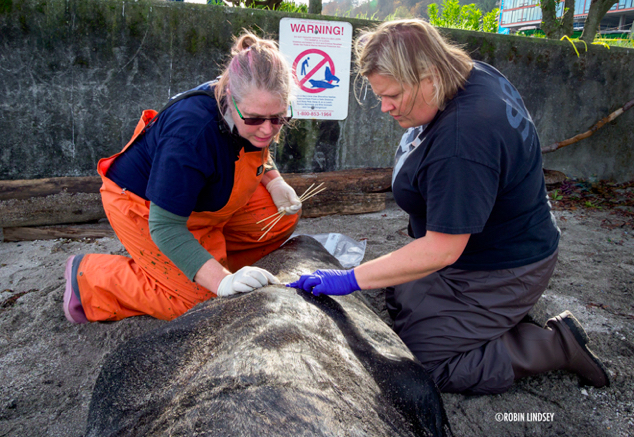
Necropsies were performed today on the two dead California sea lions that washed ashore in West Seattle this week. Evidence of bullet wounds and projectiles were found in both adult males, one with extensive internal damage. The skulls were removed and will be radiographed early next week and should reveal more conclusive results. Rib cages and many of the organs were taken for further examination for damage and projectiles.
It was truly a collaborative effort of the West Coast Marine Mammal Stranding Network partners. Shown above, WDFW marine mammal biologist Dyanna Lambourn and SR3’s Casey McLean examine entry wounds on one of the sea lions. Sno-King Marine Mammal Response Lead Investigator Rachel Mayer assisted.
Seal Sitters MMSN First Responders and volunteers provided support with photo documentation and entry of data, kept the area secure and educated the public. NOAA’s Brad Hanson and fellow orca researcher Mark Sears, who were headed out to observe J and K pods, offered to tow one of the massive sea lions with their inflatable research boat to Don Armeni boat launch, where the necropsy crew was standing by.
After the first animal had been worked up, Laura James and colleague Rick Rasmussen rounded Duwamish Head in his Boston Whaler to fetch the second dead animal, wedged along the shoreline below Alki Avenue. They returned with the fresh dead animal in tow.
Many thanks to Seattle Parks’ Carol Baker and the crew from the Heavy Equipment department, whose backhoe lifted the carcass remnants (many hundreds of pounds) into the bed of WDFW’s pickup so that the remains could be properly disposed of.
Thanks to everyone who went the extra mile to make sure these two beautiful animals were properly examined - and prove that they had indeed been shot. Evidence will be turned over to NOAA’s Office of Law Enforcement for investigation.
Please be on the alert. NOAA urges the public to report any information or incidents they see or hear to NOAA Office of Law Enforcement: during regular business hours, call 206-526-6133, after hours 1-800-853-1964.
Shot sea lions under federal investigation
Nov/15/18 06:01 AM
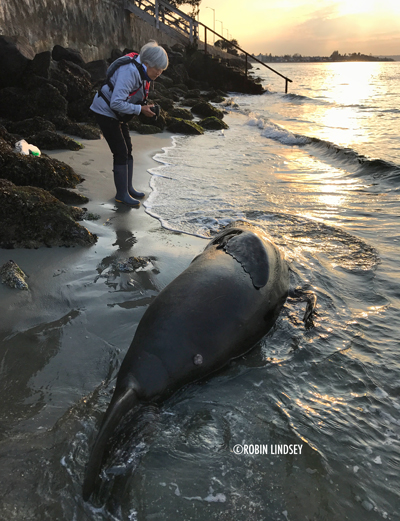
The numbers of these gregarious animals increase in fall months as they migrate to our area in search of food. Coinciding with fishing season and salmon runs, sea lion killings also increase each fall. Seals and sea lions are too often scapegoated for dwindling fish stocks - and pay the ultimate price with their lives.
For almost two months now, dead sea lions have been washing up along West Seattle’s shoreline. Since early October, necropsies revealed that two animals had been shot in the head (confirmed by radiographs). Projectiles were recovered and turned over to NOAA’s Office of Law Enforcement for what is an open and active inquiry.
In just the past week, Seal Sitters’ First Responders have investigated three more deceased sea lions. In the photo above, SSMMSN Co-Investigator Lynn Shimamoto photo documents the condition of an 8-foot, fresh dead male below the Alki Avenue sea wall. A limited initial exam, due to surging tide, revealed a bleeding, small circular wound on the animal’s back along with additional wounds of unknown origin.
Due to location and tide, responders were unable to secure the sea lion to shore. The hope is to tow the now floating carcass to a secure location for a necropsy. The animal was marked with biodegradable livestock paint for identification and was last sighted near Duwamish Head yesterday.
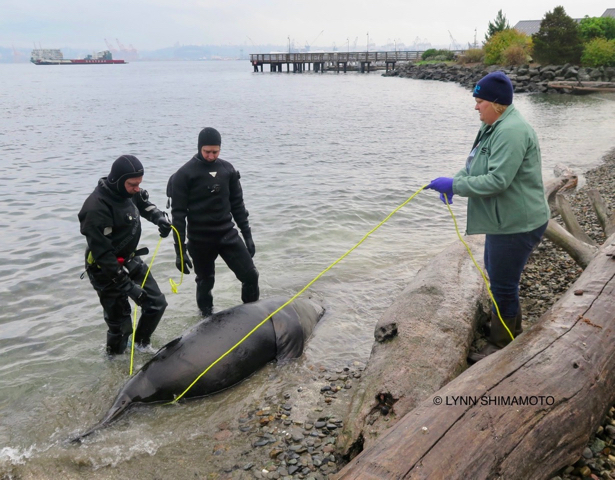 Early yesterday morning, Lynn responded to yet another report of a dead sea lion, floating just offshore near the public fishing pier. With the help of divers Jim and Joe, Seal Sitters volunteer and Co-Director of SR3 Casey McLean (photo above), and Lynn managed to tie the 9-foot robust animal, estimated to weigh about 900 lbs, to beach driftwood. An initial exam revealed three wounds on the head and shoulder of this fresh-dead animal that may have contributed to death. Seal Sitters has initiated a plan for necropsy and disposal.
Early yesterday morning, Lynn responded to yet another report of a dead sea lion, floating just offshore near the public fishing pier. With the help of divers Jim and Joe, Seal Sitters volunteer and Co-Director of SR3 Casey McLean (photo above), and Lynn managed to tie the 9-foot robust animal, estimated to weigh about 900 lbs, to beach driftwood. An initial exam revealed three wounds on the head and shoulder of this fresh-dead animal that may have contributed to death. Seal Sitters has initiated a plan for necropsy and disposal.Additionally, there are four suspected acute trauma cases (possibly shot) on the Kitsap peninsula, a similar report of a case in Hood Canal and reports of three other possible cases from neighboring Marine Mammal Stranding Networks. These are just the cases we are aware of and likely the tip of the iceberg. Due to EPA permit restrictions regarding disposal of carcasses, these necropsies have been stalled until the permits come through, often taking weeks to be issued.
All marine mammals are protected from harm by Federal law, the Marine Mammal Protection Act. Over the past weeks, Seal Sitters hotline (206-905-7325) and first responders have received numerous reports of violence against sea lions and shots fired, often at night. A caller from South Park also reported witnessing a fishing boat intentionally run over and strike a sea lion in the Duwamish River.
NOAA urges the public to report any information or incidents they see or hear to NOAA Office of Law Enforcement: during regular business hours, call 206-526-6133, after hours 1-800-853-1964. A vigilant public - eyes and ears along the waterfront - is a valuable resource for enforcement and might help solve these potential crimes.
Investigation widens as more shot sea lions found in Puget Sound
Feb/02/12 05:40 PM

in Puget Sound, there have been 4 California sea lions and 1 adult harbor seal; in Hood Canal, 1 threatened Steller sea lion; on the outer coast of Washington, 1 California sea lion; most recent, in the Nisqually Refuge, 1 California sea lion.
Unsubstantiated reports this week by some media of a “shot baby sea lion” were untrue. Instead, a dead harbor seal pup was reported at Picnic Point in Edmonds. The reporting party said the animal was shot and gave an incorrect identity of species. There was no evidence of foul play when photos of the pup were reviewed by marine mammal stranding experts. Most likely, the person who found the animal mistakenly thought the pup’s tiny ear hole was a bullet entry wound. This is a common misconception by the public since harbor seals have no external ear flap.
Determining the cause of death for a marine mammal can challenge even the most experienced of biologists. Small entry wounds are extremely difficult to see on a massive, often decomposed animal. According to WDFW marine mammal biologist Dyanna Lambourn, more often than not, trauma from a bullet (such as hemorrhaging and tissue damage) is usually discovered once the animal is opened up for necropsy. Once the damage is discovered, the investigators are able to track back through the body to find the entry wound. Often, there is suspicion of a bullet wound, but the bullet itself is not found on initial exam. Radiographs reveal clear evidence of fragmented bone and often the embedded bullet itself. Dyanna is shown here (photo above) reviewing radiographs of recent sea lion shootings. These new radiographs proved that the Lincoln Park sea lion had been shot in the head as well as left lung.
It is imperative that the public continue to call with reports of all dead seals and sea lions: call NOAA’s hotline at 1-800-853-1964 or Seal Sitters’ Hotline at 206-905-7325 (SEAL) for all West Seattle reports. Scavenger damage and natural decomposition can cause small external wounds and holes in the carcasses of dead marine mammals. Please do not assume the animal you are reporting has been shot. When at all possible, trained professionals will respond if the condition of the animal is fresh and the best available data can be collected. Photos from the public are helpful in determining species and general condition in case the animal cannot be located or if response is not possible. When reporting, please provide hotline operators with as precise a location of the animal as possible, including notable landmarks. Necropsies are performed to keep tabs on the health of the populations and monitor signs for outbreak of disease or other factors contributing to death - and, of course, provide evidence if indeed there is foul play.
There is an on-going investigation by NOAA’s Office for Law Enforcement regarding the shooting deaths of these animals. Please call 1-800-853-1964 to report any suspicious activity regarding marine mammal harassment or if you have any information regarding these shootings. Sea Shepherd Society has offered a $10,000 reward for information leading to arrest and conviction in this case.
Latest information from NOAA/WDFW regarding sea lion deaths
Mar/09/10 04:43 PM
(text courtesy NOAA/WDFW)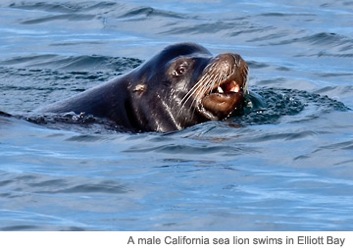
In January and February 2010 the Northwest Marine Mammal Stranding Network received numerous calls about dead sea lions in Puget Sound. There were a total of 19 reports of dead sea lions from Kingston south to Olympia. Eleven of those reported have been located and responded to from a number of network responders, which includes Washington Dept of Fish and Wildlife Marine Mammal Investigations, Cascadia Research Collective, NOAA Fisheries, and West Seattle Seal Sitters.
Of the eleven carcasses examined, ten of the animals were confirmed as shot. Two of the animals were Steller sea lions which are threatened under the Endangered Species Act. Eight of the animals were CA sea lions and one other sea lion is suspected to have been shot, but could not be confirmed.
All marine mammals are protected by the Marine Mammal Protection Act (MMPA) and shooting these animals is illegal. The NOAA Office for Law Enforcement investigates violations of the MMPA and has a 24 hour hotline to take reports from the public.
Read More...

In January and February 2010 the Northwest Marine Mammal Stranding Network received numerous calls about dead sea lions in Puget Sound. There were a total of 19 reports of dead sea lions from Kingston south to Olympia. Eleven of those reported have been located and responded to from a number of network responders, which includes Washington Dept of Fish and Wildlife Marine Mammal Investigations, Cascadia Research Collective, NOAA Fisheries, and West Seattle Seal Sitters.
Of the eleven carcasses examined, ten of the animals were confirmed as shot. Two of the animals were Steller sea lions which are threatened under the Endangered Species Act. Eight of the animals were CA sea lions and one other sea lion is suspected to have been shot, but could not be confirmed.
All marine mammals are protected by the Marine Mammal Protection Act (MMPA) and shooting these animals is illegal. The NOAA Office for Law Enforcement investigates violations of the MMPA and has a 24 hour hotline to take reports from the public.
Read More...
Necropsies in progress
Feb/21/10 06:22 PM
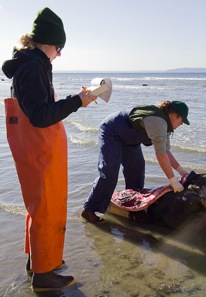
More necropsies to be performed by WDFW
Feb/16/10 11:42 AM
Washington Dept. of Fish and Wildlife (WDFW) plans to respond and necropsy an additional four California sea lions to investigate cause of death. Please check back for updates when available.
Authorities from NOAA and WDFW would like to stress that it is extremely difficult to tell upon a visual examination if a marine mammal has been shot. A bullet entry wound is quite small and particularly difficult to see on a fur-covered animal, much less one that has been dead in the water or on shore for some time; fur tends to rub off in circular spots and scavengers (both marine and terrestrial) can create wounds that might appear to the layperson as a bullet wound. Indeed, the biologists have to search quite extensively through blubber layers, muscle and tissue to find signs of bullet entry and hemmoraging in hopes of retrieving a bullet. Often, it can only be determined by radiography. So, if you find a dead seal or sea lion, please do not assume the animal has been shot. Report it immediately to NOAA’s hotline 1-800-853-1964 or in West Seattle, call Seal Sitters dispatch @ 206-905-7325 (SEAL).
Authorities from NOAA and WDFW would like to stress that it is extremely difficult to tell upon a visual examination if a marine mammal has been shot. A bullet entry wound is quite small and particularly difficult to see on a fur-covered animal, much less one that has been dead in the water or on shore for some time; fur tends to rub off in circular spots and scavengers (both marine and terrestrial) can create wounds that might appear to the layperson as a bullet wound. Indeed, the biologists have to search quite extensively through blubber layers, muscle and tissue to find signs of bullet entry and hemmoraging in hopes of retrieving a bullet. Often, it can only be determined by radiography. So, if you find a dead seal or sea lion, please do not assume the animal has been shot. Report it immediately to NOAA’s hotline 1-800-853-1964 or in West Seattle, call Seal Sitters dispatch @ 206-905-7325 (SEAL).
Humane Society offers reward for sea lion killings
Feb/12/10 11:13 AM
Just released by the HSUS:
Reward Offered in Sea Lion Poaching Case in West Seattle
(Feb. 12, 2010) - The Humane Society of the United States and The Humane Society Wildlife Land Trust are offering a reward of up to $2,500 for information leading to the arrest and conviction of the person or persons responsible for the deaths of five sea lions.
According to published media reports, five sea lions were found dead on a West Seattle beach over the past week. Necropsies revealed that the animals died of gunshot wounds and had been dead for one to two weeks. "The individual or individuals responsible for this callous poaching have an appalling disregard for both sea lions and the laws that exist to protect these iconic animals," said Dan Paul, Washington state director for The HSUS. "The Humane Society of the United States applauds the National Marine Fisheries Service for investigating this case."
One of the dead sea lions was a Steller sea lion, which is protected by the federal Endangered Species Act and the Marine Mammal Protection Act. The others were California sea lions, which are also protected by the MMPA. If convicted, the poacher may face a $50,000 fine.
Every year, thousands of poachers are arrested nationwide; however, it is estimated that only 1 percent to 5 percent of poachers are caught. Poachers kill wildlife anytime, anywhere and sometimes do so in particularly cruel ways.
Anyone with information about this case is asked to call the National Marine Fisheries Service at 1-800-853-1964.
The HSUS Media Contact: Liz Bergstrom, 240-751-0659, ebergstrom@humanesociety.org
The HSUS works to stop wildlife abuse across the country. Visit humanesociety.org/wildlifeabuse for more information.
Reward Offered in Sea Lion Poaching Case in West Seattle
(Feb. 12, 2010) - The Humane Society of the United States and The Humane Society Wildlife Land Trust are offering a reward of up to $2,500 for information leading to the arrest and conviction of the person or persons responsible for the deaths of five sea lions.
According to published media reports, five sea lions were found dead on a West Seattle beach over the past week. Necropsies revealed that the animals died of gunshot wounds and had been dead for one to two weeks. "The individual or individuals responsible for this callous poaching have an appalling disregard for both sea lions and the laws that exist to protect these iconic animals," said Dan Paul, Washington state director for The HSUS. "The Humane Society of the United States applauds the National Marine Fisheries Service for investigating this case."
One of the dead sea lions was a Steller sea lion, which is protected by the federal Endangered Species Act and the Marine Mammal Protection Act. The others were California sea lions, which are also protected by the MMPA. If convicted, the poacher may face a $50,000 fine.
Every year, thousands of poachers are arrested nationwide; however, it is estimated that only 1 percent to 5 percent of poachers are caught. Poachers kill wildlife anytime, anywhere and sometimes do so in particularly cruel ways.
Anyone with information about this case is asked to call the National Marine Fisheries Service at 1-800-853-1964.
The HSUS Media Contact: Liz Bergstrom, 240-751-0659, ebergstrom@humanesociety.org
The HSUS works to stop wildlife abuse across the country. Visit humanesociety.org/wildlifeabuse for more information.
News media reports of 5 shot sea lions in WS inaccurate
Feb/13/10 10:09 AM
Published reports by the news media that 5 sea lions have been found shot on West Seattle beaches are erroneous. In fact, three sea lions (1 Steller and 2 California sea lions) dead from gunshot wounds have washed up on our shore. The other two shot sea lions were found in Burien and Gig Harbor. As sometimes can happen when a news story is fast breaking, information can get misconstrued.
According to DFW, there are an estimated 3-9 additional sea lions floating in the water. This number is vague due to the fact that the same sea lion may be sighted over and over in different locations. This stresses the need for a dead animal onshore to be reported immediately so that authorities can mark and secure the animal for possible necropsy. Seal Sitters reminds you that when reporting any marine mammal onshore (dead or alive) give as precise a location as possible in a timely manner.
According to DFW, there are an estimated 3-9 additional sea lions floating in the water. This number is vague due to the fact that the same sea lion may be sighted over and over in different locations. This stresses the need for a dead animal onshore to be reported immediately so that authorities can mark and secure the animal for possible necropsy. Seal Sitters reminds you that when reporting any marine mammal onshore (dead or alive) give as precise a location as possible in a timely manner.
News links for sea lion shootings
Feb/12/10 04:48 PM
We are providing links to all news stories posted regarding the sea lion and seal shootings in Puget Sound. Links will be updated as new stories emerge.
There are some inaccuracies in the stories reported by media. One important point to correct is the statement that we have had “only three seals” show up dead since 2007. Quite the contrary, we have had a number of harbor seals (adults and pups) over the past several years that have died from “natural” causes ~ including parasites and viruses. In the fall of 2007, a dead California sea lion came ashore at Don Armeni boat ramp where a necropsy was performed and a bullet recovered. In October of 2008, we also had a dead sea lion on a private beach that was not necropsied. SS photographed and marked the animal. The sea lion went out with the tide and eventually appeared in late November on the north stretch of Alki Beach where he was buried with a backhoe.
Additionally, the photo by a citizen of a sea lion wedged in the rocks near Cormorant Cove has been positively identified by photo comparison. It is the second CA sea lion necropsied late in the afternoon on the 11th.
Television:
KOMO 4 News story KOMO 4 video
KIRO 7 News story KIRO 7 video
KING 5 story and video CTV News (Canada)
Newspapers and Web blogs
West Seattle Blog, Seattle Times, Associated Press, LA Times, San Francisco Chronicle
There are some inaccuracies in the stories reported by media. One important point to correct is the statement that we have had “only three seals” show up dead since 2007. Quite the contrary, we have had a number of harbor seals (adults and pups) over the past several years that have died from “natural” causes ~ including parasites and viruses. In the fall of 2007, a dead California sea lion came ashore at Don Armeni boat ramp where a necropsy was performed and a bullet recovered. In October of 2008, we also had a dead sea lion on a private beach that was not necropsied. SS photographed and marked the animal. The sea lion went out with the tide and eventually appeared in late November on the north stretch of Alki Beach where he was buried with a backhoe.
Additionally, the photo by a citizen of a sea lion wedged in the rocks near Cormorant Cove has been positively identified by photo comparison. It is the second CA sea lion necropsied late in the afternoon on the 11th.
Television:
KOMO 4 News story KOMO 4 video
KIRO 7 News story KIRO 7 video
KING 5 story and video CTV News (Canada)
Newspapers and Web blogs
West Seattle Blog, Seattle Times, Associated Press, LA Times, San Francisco Chronicle
Sea lion necropsy updates
Feb/12/10 10:51 AM
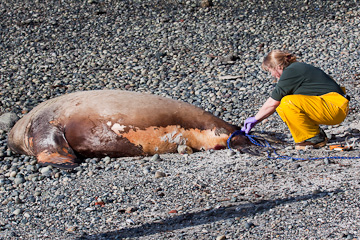
Additionally, it is believed that the second California sea lion necropsied late yesterday afternoon likely died from a bullet, but test results have not yet been completed to confirm this suspicion.
4 dead pinnipeds on West Seattle beaches
Feb/11/10 11:28 PM
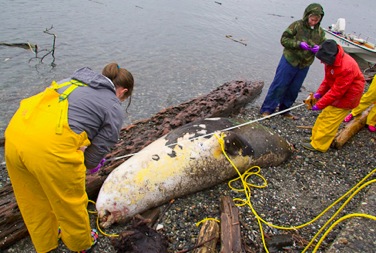
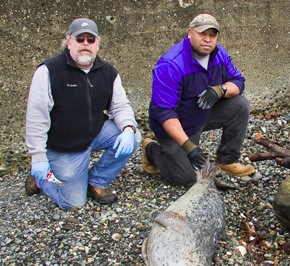
The body of the adult harbor seal was taken by the DFW for necropsy at their office. The decomposed body of a harbor seal on Constellation Park beach was buried by Parks earlier in the day. The bodies of the three marine mammals were secured with ropes by SS volunteers and Parks so that they would not go out with the tides before biologists could arrive on scene. Seal Sitters would like to thank Dan and Simi of Parks (shown at left with the harbor seal taken for necropsy) for their on-going help.
Please check back for updates as this story develops.
Steller sea lion necropsy on private beach
Feb/02/10 10:49 PM
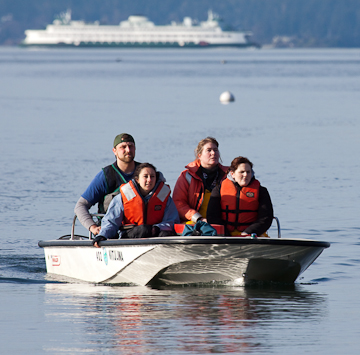
Stellers are the largest of all sea lions and can weigh up to 2500 pounds. Lighter in color than California sea lions, another distinguishing feature is a broadened head with less prominent bump on the forehead (sagittal crest). Their population numbers have plummeted in recent years and the western stock is on the endangered list. Read more about Steller sea lions here.







